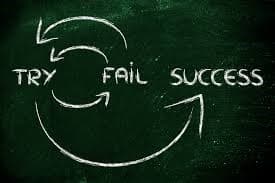“All good lessons come at a cost. Try to learn them inexpensively.” Howard Zucker
When I made a mistake as a child, my father would remind me that all lessons come at a cost. The goal was to learn them cheaply. I did not always follow this maxim. But, this pearl of wisdom stayed with me throughout my life. I have passed it on to my children. It also shaped my approach to management and leadership.
Examining my father’s advice, I recognized that some mistakes could easily be corrected, and others were permeant—like knocking out my front teeth. I learned the sooner you admitted there was a problem, the easier it was to resolve. And, accepting responsibility and owning the issue, was always best.
In this article, I share my experience and best practices for learning quickly and cheaply from our mistakes.
Trust Your People
Early in my career, I recognized that penalizing people for mistakes had unexpected, negative consequences. Punishment did not reduce the likelihood of future problems. Rather, people would hide or cover up what happened. We had fewer issues; but they were bigger and more consequential. We did not learn the cheap lessons.
Managers should create a trusting and safe work-environment. Assume best intentions. In other words, expect that your staff is doing its best. One of my mentors, Mark Horstman says, “Nobody goes to work planning to screw up.” Most errors are unintentional.
In the 1950s, Douglas McGregor developed a theory of management behaviors—Theory X and Theory Y.
Theory X mangers follow tradition practices. Their role is to oversee and supervise employees. They are controlling, closed, and unapproachable. They use blame and punishment as a primary tool. This is not a safe or trusting environment. At best employees will hide their mistakes; in some cases, they may deliberately undermine or sabotage the process.
Theory Y managers by contrast, believe that employees strive to do the right thing. Managers should create a supportive environment where employees can succeed. They are open and approachable. Employees are more likely to disclose errors and will feel comfortable seeking guidance from their managers.
Theory Y organizations have a lower cost of learning. The lesson is learned once and the experience is shared across the team. Problems are not viewed as a personal short-coming, but as a process failure. The quality guru, W. Edward Deming noted, “A bad system will beat a good person every time.”
In these organizations, systemic issues are identified and resolved. Multiple workarounds are avoided. Best practices are developed to address complex situations.
As a manager, create an environment where employees are not afraid to make or admit mistakes—treat them as teachable moments. Review the events with the employee:
- Is there a lesson to be learned? Was this a common or rare set of circumstances?
- What information was used to make the decision? What other information could have been helpful?
- Was the situation properly assessed? What else could or should have been considered?
- How might you assess and respond to the same fact pattern in the future?
When conducting post-mortems, I often find that decisions and actions were reasonable in that moment based on the available information. However, as events unfolded the situation changed. It is very easy to spot mistakes in retrospect—hindsight has 20/20 vision. When reexamining events, play the tape both forward and backward—both views provide perspective.
Feel Empowered
Managers and project managers play a large role in forming the team environment and culture.
The first step is clearly defining and articulating your values and expectations. The next step is regularly communicating them. Tell inspirational stories to reinforce the values. Never miss an opportunity share a story that highlights them—people will remember.
Align your actions to your words. The old expressions, “talk is cheap” and “actions speak louder than words” are true. No matter what you say, people will watch what you do. How you respond to a situation demonstrates your true beliefs.
Self-managing, Agile teams co-create their environment. Establishing and documenting norms and expected behaviors in the team charter is a great first step. Living by them is the next one.
Managers that feel inhibited by the larger organization’s culture should recognize this constraint and move forward to create the environment they want. Throughout my career, I created positive and constructive environments—sometimes despite the organization’s overall culture.
To quote Mahatma Gandhi, “Be the change you want to see in the world.”
Encourage Experimentation
We typically consider experiments to be the domain of research and innovation groups. Experimentation is a powerful tool that can be applied to business operations and projects. Create an environment that encourages people to question and find better ways of working.
How can a project team or operations group experiment?
First, create an environment and business practices where teams regularly evaluate how they perform. Take an Agile approach. Scrum builds continuous improvement and experimentation into its methodology. At the end of each development sprint, the team holds a Retrospective. In the retrospective, the team identifies ways to improve. Then, they implement the highest priority changes in the next iteration. Afterwards, they review the outcome and assess the effect.
The Shewhart (Deming) Plan-Do-Check-Act Cycle is a standard framework for building, assessing, and adjusting a business process:
- Plan. Develop a plan for executing the work. Identify performance metrics and expectations;
- Do. Execute the work for a period of time and collect data;
- Check. Review the progress. Did the team achieve the desired results? Identify and prioritize further adjustments and changes; and
- Act. Implement the changes and begin the next execution cycle.
Some teams resist establishing performance goals and collecting metrics. They may fear the results will be used against them. Or, they may over-complicate the process of collecting and analyzing the data. As the economist, John Maynard Keynes said, “It is better to be roughly right, than precisely wrong.”
Once, I established an audacious cost reduction goal. Due to issues with the financial data, getting a precise measure was impossible. We considered creating a complicated model. But that would require a substantial amount of effort. Instead, we opted to use high-level measures that were easy to gather. Even with these less accurate measures, we demonstrated our ability to reduce costs by roughly 40%.
Prototyping is another experimentation tool. It lets the team collect results-based feedback before making an investment in a highly formalized process or automation tool. Prototyping is often associated with consumer products. However, the same principals can be applied to internal processes and applications development.
Use the PDCA model. Develop a basic, initial process—the simpler, the better. Execute the process. Identify and implement improvements. Incrementally mature the process. Consider automating the process only after it is well-understood. A key to success is starting simple and adding complexity as facts dictate. For example, build exception handling rules based on experience; rather than theoretical threats.
Blameless Retrospectives
Retrospectives are a constructive way to review operational performance, projects, and incidents. A well-facilitated session can be an effective way to conduct the retrospective.
I recommend using structured brainstorming techniques that optimize how our brains function by leveraging divergent and convergent thought processes. Develop as many ideas as possible (divergent) and then focus on the most important ones (convergent). For retrospectives, use this process outline:
- Participants individually brainstorm sources of operational issues or opportunities for improvement. Each idea is written on a Post It Note®;
- The Post It Notes are then placed on the wall and categorized. Use the dot voting technique to identify the issues or ideas that are most important or the highest priority;
- The team focuses its attention on discussing the highest priority items. The facilitator directs the meeting to fact gathering and problem solving.
This framework can be used to identify opportunities as well as solutions. As teams become more comfortable with the process and mature their practices, they will quickly apply it to a wide variety of group learning and improvement activities.
In today’s business environment, organizations need to continually improve and mature. Following the principles of Kaizen—continuous improvement—we should develop practices that encourage our teams to quickly learn from their mistakes. Managers play a critical role in creating the environment and helping develop these skills.
© 2018, Alan Zucker; Project Management Essentials, LLC
To learn more about our training and consulting services, or to subscribe to our Newsletter, visit our website: www.pmessentials.us.
Related Project Management Essentials articles:
- Conducting a Successful Brainstorming Meeting
- Failing Fast for the Rest of Us
- Owning the Issue: A Profile in Courage
- Our Own Inspirational Stories
Image courtesy of: http://leecaraher.com


